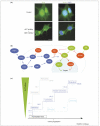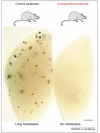The Gli code: an information nexus regulating cell fate, stemness and cancer
- PMID: 17845852
- PMCID: PMC2601665
- DOI: 10.1016/j.tcb.2007.06.007
The Gli code: an information nexus regulating cell fate, stemness and cancer
Abstract
The Gli code hypothesis postulates that the three vertebrate Gli transcription factors act together in responding cells to integrate intercellular Hedgehog (Hh) and other signaling inputs, resulting in the regulation of tissue pattern, size and shape. Hh and other inputs are then just ways to modify the Gli code. Recent data confirm this idea and suggest that the Gli code regulates stemness and also tumor progression and metastatic growth, opening exciting possibilities for both regenerative medicine and novel anticancer therapies.
Figures





References
-
- Ruiz i Altaba A, editor. Hedgehog-Gli signaling in human disease. Landes Bioscience; Georgetown: 2006.
-
- Ruiz i Altaba A. Catching a Gli-mpse of Hedgehog. Cell. 1997;90:193–196. - PubMed
-
- Ruiz i Altaba A, et al. The emergent design of the neural tube: prepattern, SHH morphogen and GLI code. Curr. Opin. Genet. Dev. 2003;13:513–521. - PubMed
-
- Ruiz i Altaba A. Combinatorial Gli gene function in floor plate and neuronal inductions by Sonic hedgehog. Development. 1998;125:2203–2212. - PubMed
-
- Ruiz i Altaba A. Gli proteins encode context-dependent positive and negative functions: implications for development and disease. Development. 1999;126:3205–3216. - PubMed
Publication types
MeSH terms
Substances
Grants and funding
LinkOut - more resources
Full Text Sources
Other Literature Sources
Medical

